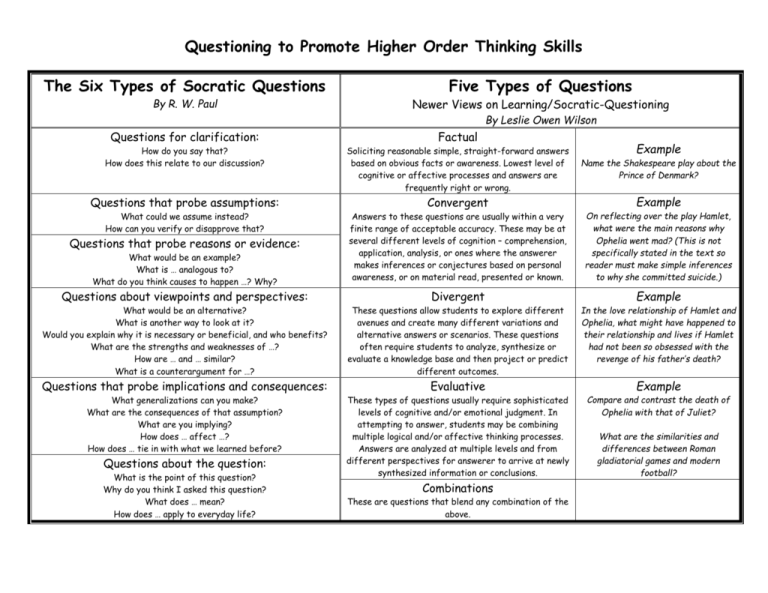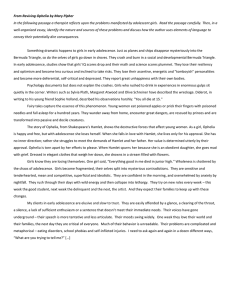Questioning Techniques for Higher-Order Thinking
advertisement

Questioning to Promote Higher Order Thinking Skills The Six Types of Socratic Questions Five Types of Questions By R. W. Paul Newer Views on Learning/Socratic-Questioning By Leslie Owen Wilson Questions for clarification: How do you say that? How does this relate to our discussion? Factual Soliciting reasonable simple, straight-forward answers based on obvious facts or awareness. Lowest level of cognitive or affective processes and answers are frequently right or wrong. Questions that probe assumptions: Convergent What could we assume instead? How can you verify or disapprove that? Answers to these questions are usually within a very finite range of acceptable accuracy. These may be at several different levels of cognition – comprehension, application, analysis, or ones where the answerer makes inferences or conjectures based on personal awareness, or on material read, presented or known. Questions that probe reasons or evidence: What would be an example? What is … analogous to? What do you think causes to happen …? Why? Questions about viewpoints and perspectives: Divergent Example Name the Shakespeare play about the Prince of Denmark? Example On reflecting over the play Hamlet, what were the main reasons why Ophelia went mad? (This is not specifically stated in the text so reader must make simple inferences to why she committed suicide.) Example What would be an alternative? What is another way to look at it? Would you explain why it is necessary or beneficial, and who benefits? What are the strengths and weaknesses of …? How are … and … similar? What is a counterargument for …? These questions allow students to explore different avenues and create many different variations and alternative answers or scenarios. These questions often require students to analyze, synthesize or evaluate a knowledge base and then project or predict different outcomes. In the love relationship of Hamlet and Ophelia, what might have happened to their relationship and lives if Hamlet had not been so obsessed with the revenge of his father’s death? Questions that probe implications and consequences: Evaluative Example What generalizations can you make? What are the consequences of that assumption? What are you implying? How does … affect …? How does … tie in with what we learned before? Questions about the question: What is the point of this question? Why do you think I asked this question? What does … mean? How does … apply to everyday life? These types of questions usually require sophisticated levels of cognitive and/or emotional judgment. In attempting to answer, students may be combining multiple logical and/or affective thinking processes. Answers are analyzed at multiple levels and from different perspectives for answerer to arrive at newly synthesized information or conclusions. Combinations These are questions that blend any combination of the above. Compare and contrast the death of Ophelia with that of Juliet? What are the similarities and differences between Roman gladiatorial games and modern football? Bloom’s Taxonomy Levels of Questioning Knowledge Identification and recall of information Knowledge of dates, events, places Knowledge of major ideas Mastery of subject matter Comprehension Question Cues Examples List Define Tell Describe Identify Show Label Collect Examine Tabulate Quote Name Who When Where Explain Discuss Compare Extend Interpret Predict Describe Contrast Outline Restate Summarize Distinguish Application Apply Demonstrate Calculate Complete Use information, rules, principles Use methods, concepts, theories in new situations Solve problems using required skills or knowledge Illustrate Show Solve Examine Modify Relate Change Classify Analysis Analyze Explain Arrange Select Separate Connect Divide Infer Order Classify Compare Debate Organization and selection of facts and ideas Interpretation of facts, compare, contrast Order, group and infer causes Predict consequences Understanding information Grasping meaning Translate knowledge into new context Separation of the whole into component parts Seeing patterns Organization of parts Recognition of hidden meanings Synthesis Use of old ideas to create new ones Relate knowledge from several areas Generalize from given facts Predict, draw conclusions Evaluation Development of opinions, judgments, or decisions Make choices based on reasoned argument Verify value of evidence Recognize subjectivity & assess value of theories Combine Rearrange Create What if? Rewrite Design Integrate Substitute Compose Prepare Modify Plan Invent Formulate Generalize Assess Grade Recommend Judge Decide Test Convince Support Rank Measure Select Conclude List the main characteristics for the main characters. Arrange scrambled story pictures in sequential order. Match statements with the characters who said them. Describe …. Draw a picture showing what happened before and after a passage or illustration. Retell … in your own words. What is the main idea of …? Construct a pictorial timeline which summarizes what happens in the story. Transfer the new character to a new setting. Why is … significant? Do you know another situation where …? What factors would you change if …? Select parts of the story that were funniest, saddest, happiest, most unbelievable. Compare and/or contrast two of the main characters. Differentiate fact from opinion. What evidence can you list for …? Classify … according to …. Advertise the story on a poster to make people want to read it. Write the lyrics and music to a song for one of the characters to sing. How would you create/design a new …? Rewrite two new titles for the story. Do you agree with …? Write a recommendation for …. Prioritize …. What criteria would you use to assess …? Judge whether or not the character should have acted the way they did.











